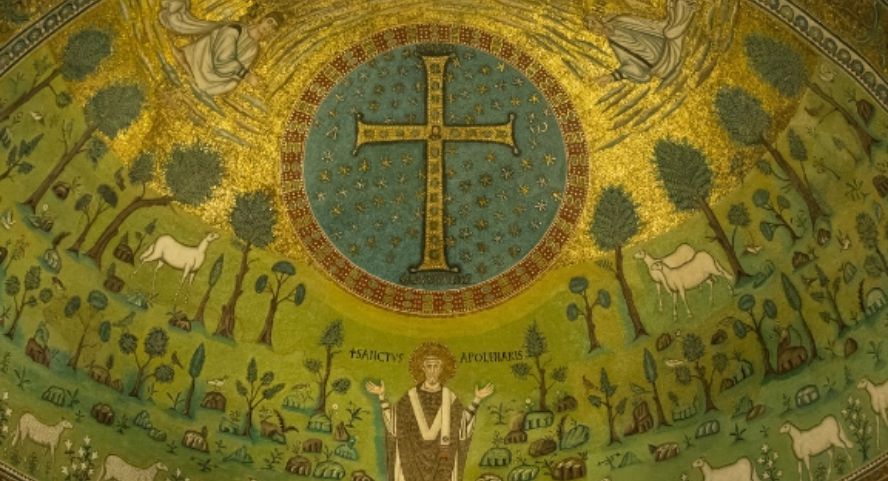Serpents-Sirens in St Isidore of Seville. The Question of Name Attribution
Abstract
The topic of the article is the question of the name of Arabia’s flying serpents that, according to Isidore of Seville’s account, were to be called by the name of sirens. Tales about winged serpents had had a centuries-old tradition even before Isidore, in the Greek and Latin literatures. They appeared for the first time in the 5th century BC thanks to Herodotus and his Histories II 75-76. However, not until Isidore of Seville and his Etymologiae XIV 3,7 were those serpents specifically referred to as sirens. The author of the article traces back the surviving texts by both the pagan and Christian authors. He tries to find out what the Isidore’s source of this piece of information was. As a result of his research, the author points to a mysterious mention found in St. Jerome’s Commentary on Isaiah. After its thorough analysis, based on other texts by Jerome, the author explains how the name of sirens – previously not related to the tale about Arabia’s winged serpents – has been incorporated into their description created by Isidore.
Keywords:
Sirens, snake, dragon, translation studies, exegesis, St Isidore of Sevilla, St JeromeReferences
Biblia Hebraica Stuttgartensia, ed. A. Schenker, Stuttgart 1997.
Biblia Sacra iuxta Vulgatam versionem, ed. R. Weber – R. Gryson, Stuttgart 2013.
Caius Julius Solinus, Collectanea rerum memorabilium, ed. T. Mommsen, Berolini 1895.
Gajusz Juliusz Solinus, Zbiór wiadomości godnych uwagi albo Polihistor, tł. B.J. Kołoczek, Kraków 2020.
Gajusz Pliniusz Sekundus, Historia naturalna. Tom 2: Antropologia i Zoologia. Księgi 7-11, tł. I. Mikołaczyk, Toruń 2019.
Haymo Autissiodorensis, Annotatio libri Isaiae prophetae, ed. R. Gryson, Corpus Christianorum. Continuatio Mediaevalis 135C, Turnhout 2014.
Herodotus, Historiae, ed. K. Hude, Oxford 1927.
Herodot, Dzieje, tł. S. Hammer, Warszawa 1954.
Hieronymus, Apologia adversus libros Rufini, PL 23, 397-492.
Św. Hieronim, Apologia przeciw Rufinowi, tł. S. Ryznar, PSP 41, Warszawa 1989.
Hieronymus, Commentarii in Esaiam, ed. M. Adriaen, CCL 73, Turnhout 1963.
Hieronymus, Commentarii in Hieremiam, ed. S. Reiter, CCL 74, Turnhout 1960.
Hieronymus, Commentarii in Prophetas Minores, ed. M. Adriaen, CCL 73, Turnhout 1969.
Hieronymus, Epistulae 71-120, ed. I. Hilberg, Corpus Scriptorum Ecclesiasticorum Latinorum 55, Vindobonae 1912.
Brunetto Latini, Li Livres dou Tresor, ed. S. Baldwin – P. Barrette, Medieval and Renaissance Texts and Studies 257, Tempe 2003;
Brunetto Latini, Skarbiec wiedzy, tł. M. Frankowska-Terlecka – T. Giermak-Zielińska, Warszawa 1992.
Physiologus Griechisch-Deutsch, ed. O. Schönberger, Stuttgart 2001.
Pomponius Mela, De chorographia libri tres, ed. C. Frick, Stuttgartiae 1967.
Thomas Cantimpratensis, Liber de natura rerum, ed. M. Cipriani, w: http://sourcencyme.irht.cnrs.fr/encyclopedie/liber_de_natura_rerum_versions_i_ii_ed_cipriani_en_cours_2017?citid=cit_idp73136640 (dostęp 21.06.2024).
Asheri D. – Lloyd A. – Corcella A., A Commentary on Herodotus Books I-IV, Oxford – New York 2007.
Bochart S., Hierozoicon sive de animalibus sacrae Scripturae, t. 2, Londini 1663.
Danysz A., Św. Hieronim i św. Augustyn a literatura świecka, „EOS” 6 (1900) s. 92-112.
Deus J., Der „Experimentator” – eine anonime lateinische Naturenzyklopadie des Fruhen 13. Jahrhunderts, Hamburg 1998.
Faral E, La queue de poisson des sirè nes , „Romania” 74/296 (1953) s. 433-506.
Field F., Origenis Hexaplorum quae supersunt, t. 2, Oxonii 1875.
Hagendahl H., Jerome and the Latin Classics, „Vigiliae Christianae” 28/3 (1974) s. 216-227.
Hillgarth J.N., Isidore of Seville, w: Dictionary of the Middle Ages, t. 6, ed. J.R. Strayer, New York 1985, s. 563-566.
Holtz L., Donat et la tradition de l’enseignement grammatical. Etude sur l’Ars de Dona et sa diffusion (IVe-IXe siè cle) et édition critique, Paris 1981.
Karttunen K., Phoebo vicinus Padaeus: Reflections on the Impact of Herodotean Ethnography, w: The Children of Herodotus: Greek and Roman Historiography and Related Genres, ed. J. Pigoń, Cambridge 2009, s. 17-25.
Kelly J.D.N., Hieronim. Życie, pisma, spory, tł. R. Wiśniewski, Warszawa 2003.
Koehler L. – Baumgartner W. – Stamm J.J., Wielki słownik hebrajsko-polski i aramejsko-polski Starego Testamentu, t. 1, red. P. Dec, Warszawa 2008.
Kitchell Jr. K.F., Animals in the Ancient World from A to Z, London – New York 2014.
Krynicka T., Świat roślin w XVII księdze Etymologii Izydora z Sewilli, Lublin 2007.
Krzyszczuk Ł. – Morta K., The Question of St. Jerome’s Translation ex Hebraica veritate: the Example of Deut. 8:15, „Philologia Classica” 16/2 (2021) s. 241-261.
Luebeck E., Hieronymus quos noverit scriptores et ex quibus hauserit, Lipsiae 1872.
Morta K., Z badań nad źródłami opisów zwierząt u Solinusa, „Classica Wratislaviensia” 27 (2007) s. 77-88.
Morta K., Bluszcz kontra dynia, czyli trudne początki Wulgaty, „Theologica Wratislaviensia” 6 (2011) s. 91-120.
Morta K., Syreny w Biblii w przekładzie św. Hieronima, w: Biblia w przekładach i komentarzach, red. K. Morta, Wrocław 2019, s. 31-49.
Morta K., Biblical Tannin/tannim in St. Jerome’s Translation, w: The Bible in the Patristic Period, red. M. Szram – M. Wysocki, Studia Patristica 103, Leuven 2021, s. 129-140.
Morta K., Opis bazyliszka w „Etymologiach” (XII 4, 6-9) Izydora z Sewilli, „Symbolae Philologorum Posnaniensium Graecae et Latinae” 32/1 (2022) s. 113-134.
Morta K., Ancient Commenting Literature and the Etymologies of Isidore of Seville, w: Glossae – Scholia – Commentarii. Studies on Commenting Texts in Antiquity and Middle Ages, red. M. Mejor – A. Jażdżewska – A. Zajchowska, Frankfurt am Main 2014, s. 115-125.
Morta K., Palący oddechem wąż („serpens flatu adurens”) św. Hieronima, „Vox Patrum” 87 (2023) s. 295-312.
Ogden D., Drakōn: Dragon Myth and Serpent Cult in the Greek and Roman Worlds, Oxford – New York 2013.
Platelle H., Introduction, w: Thomas de Cantimpré , les exemples du ‘Livre des abeilles’. Une vision mé dié vale , Miroir du Moyen Âge, Turnhout 1997, s. 5-56.
Radner K., The Winged Snakes of Arabia and the Fossil Site of Makhtesh Ramon in the Negev, „Wiener Zeitschrift für die Kunde des Morgenlandes” 97 (2007) s. 353-365.
Radner K., Esarhaddon’s expedition from Palestine to Egypt in 671 BCE: A trek through Negev and Sinai, w: Fundstellen: Gesammelte Schriften zur Archäologie und Geschichte Altvorderasiens ad honorem Hartmut Kühne, ed. D. Bonatz – R. Czichon – F.J. Kreppner, Wiesbaden 2008, s. 305-314.
Reynolds L.D. – Wilson N.G., Skrybowie i uczeni. O tym, w jaki sposób antyczne teksty literackie przetrwały do naszych czasów, tł. P. Majewski, Warszawa 2008.
Samolewicz Z., Składnia łacińska, opr. K. Bielawski – A. Gorzkowski, Bydgoszcz 2000.
Savigniac de J., Les „seraphim”, „Vetus Testamentum” 22 (1972) s. 320-325.
Skibiński T., Zasady interpretacji Pisma św. Świetle Prefatio do Formulae spiritalis intellegentiae Eucheriusza z Lyonu, w: Bóg Ojciec i przełom wieków w myśli patrystycznej, red. I. Salamonowicz-Górska – J. Naumowicz – S. Strękowski, Studia Antiquitatis Christianae 15, Warszawa 2001, s. 236-254.
Starowieyski M., Obraz literatury klasycznej pogańskiej w dziełach Izydora z Sewilli, literatura rzymska, „Meander” 30 (1975) s. 19-35.
Wiesman A.J., Flying Serpents, „Tyndale Bulletin” 23 (1972) s. 108-110.
License

This work is licensed under a Creative Commons Attribution-NoDerivatives 4.0 International License.
Papers published in Vox Patrum are covered by the Attribution-NoDerivatives 4.0 International (CC BY-ND 4.0) licence. Authors and users can use published works licensed under the CC-BY-ND since 2018. For earlier publications, copyrights are available under fair use rights in accordance with the Act of February 4, 1994 on copyrights and related rights.







